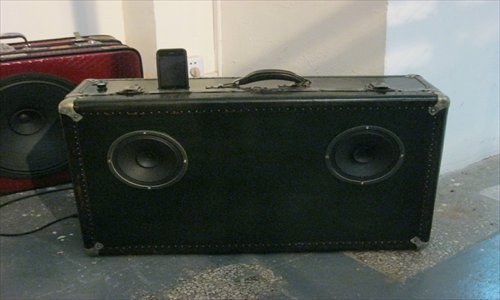
A suitcase-cum boombox which can play music from an iPhone. Photo: Li Yuting/GT
It's not unusual for old, abandoned furniture or household objects to be given a second lease of life.
However to revitalize objects for purposes other than which they were made, is still something of a novelty.
This is exactly what Jonas Merian from Switzerland does for a living in Shanghai. So owing to the creativity of the 36-year-old, an old-fashioned telephone now functions as a clock, a suitcase has become an iPhone boombox, while former biscuit tins have become the component parts of a shelf. These are not so much recycled but "up-cycled," in Merian's words.
Having a background in prosthetics and orthotics, Merian had previously worked in these fields for 17 years in Switzerland, North Korea and China. He has lived in China for the past five years, and three years ago he started to design "unique, handmade furniture and home accessories made from reclaimed, reused and re-purposed material."
Recycling pioneers
The Dutch designer, Piet Hein Eek, who is a pioneer in recycled designing, remains Merian's role model. The Swiss artist Jean Tinguely is also important to him. "When I was growing up I was fascinated by his giant sculptures made from recycled scrap metal," he told the Global Times. "I like the craftsmanship of the past, which is better than the current machine-made mass production. I always liked to work with my hands and started building my own furniture and lamps very early on."
Being a prosthetist helped Merian in working with a variety of materials including metal, wood, plastics, carbon fiber, silicone and leather.
"In the beginning, the only reason I reused some old items was simply to decorate my studio," he said. "And because of this I found I had more and more new ideas popping up," he said. His studio is based at Bldg 32, Wu Wei Creative Park on 1436 Jungong Road, Yangpu district.
His first "artwork" was originally an old Chinese dresser that he later installed with taps, pipes and plumbing and which is now a functional bathroom sink.
He changed all the hinges and polished its surface, and added a porcelain-patterned washbasin to give it a classic Chinese-style look.
Merian found this to be, not only an economic and creative way to decorate his studio, but also as a way to make money. He started buying large quantities of old furniture and items from a local dealer, some of which came from house clearances and demolitions. His purchases have included everything from planks of wood and window frames, to kettles and biscuit tins. "The amounts I pay are a secret," he said. "I don't buy items with specific ideas in mind. I just leave them in my studio and wait for ideas to come to me."
Biscuit tins are one of the most frequently re-modeled of Merian's items. These tins were popular in China from the 1970s to the 1990s. Decorated with pictures of flowers, Chinese women and children, the tins hold strong collective memories for many Chinese people, but are seldom seen anymore in local homes. On a single biscuit tin, Merian installed a loudspeaker which he connected to some audio equipment to make a music player. With dozens of other tins, he used them as a support layer to build a bookshelf.
Music makers
Merian has also put audio equipment inside an old suitcase, which also features an amplifier and two speakers attached to the front of the case. A plug socket means that an iPhone/iPod can be charged while playing amplified music. Speaking of the electro-circuit design inside, he said: "That's not what I'm good at, but I learnt how to do it after consulting from friends and online."
Another interesting design are the kettle-made lamps. Above Merian's studio worktop, there hangs a couple of such lamps lighting up the room. Merian has removed the bottom of the kettles and installed light bulbs inside.
Meanwhile a small-sized television - produced more than 30 years ago - has been emptied of its electric components and turned into a digital photograph album.
Today Merian is making a living from this one-time hobby, and business has got considerably better over the past two years. In downtown Shanghai, some of his designs can be seen in stores Hummingbird (141 Fuxing Road West) and at C'est la Chine (47 Shaoxing Road). He is now receiving orders from customers. "But if the customer has some requirements that don't adhere to my particular principle of designing style, then I wouldn't do it," he said.

Copyright ©1999-2011 Chinanews.com. All rights reserved.
Reproduction in whole or in part without permission is prohibited.